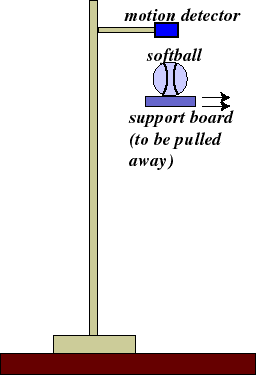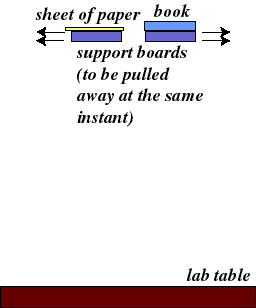![]()
Essentials of Physics- PHYS 101
Lecture 5
 Problem-solving tricks and techniques
Problem-solving tricks and techniques
 Newton's Second Law
Newton's Second Law
 Joke of the day.
Joke of the day.
 How does gravity work?
How does gravity work?
 Force of gravity
Force of gravity
 Not-so-free fall
Not-so-free fall
 Terminal velocity
Terminal velocity
![]()
 Problem-solving tricks and techniques
Problem-solving tricks and techniques
Problems solving problems?
1) You can always multiply by 1
Example: 1.6 km = 1 mile. 1.6 km / 1 mile = 1. To convert miles to km, I multiply by 1:
8.0 miles x (1.6 km / 1 mile) = 12.2 km
2) Multiply both sides of an equation by the same thing (number):
Say we know that SF = m a
Say we also know a and SF. How do I solve for m?
Multiply both sides of equation, above by the same thing (1/a):
SF (1/a) = m a (1/a) => m = SF/a
![]() More on the relationship between a, m, and F
More on the relationship between a, m, and F
Last week we observed that the acceleration of a cart doubled when the force pulling it was doubled. More generally we found that acceleration is proportional to the net force.
a µ F
What about mass?
 |
We know mass gives an object inertia which resists a change in motion. Another way to say this is more mass makes an object harder to accelerate.
What is the exact relationship between acceleration and mass?
In lab you kept the pulling force constant but changed the mass of the car. What you found (hopefully) was that if the mass of the car doubled the acceleration was reduced by half.
a µ 1/m
'acceleration is inversely proportional to mass'
put all this together to get--
Put this together with a µ F and what do we get?
a = Fnet/m more commonly written as: Fnet = ma !
But Dean, I checked F = ma in lab and it didn't work!
![]()
 How does gravity work?
How does gravity work?
| Let's observe the effect of "gravity" on a softball with the following experimental setup: |  |
Question: What happens when the board is pulled out from under the softball?
Answer: Duh, let me guess.....
Question: So, HOW is the ball moving towards the ground?





